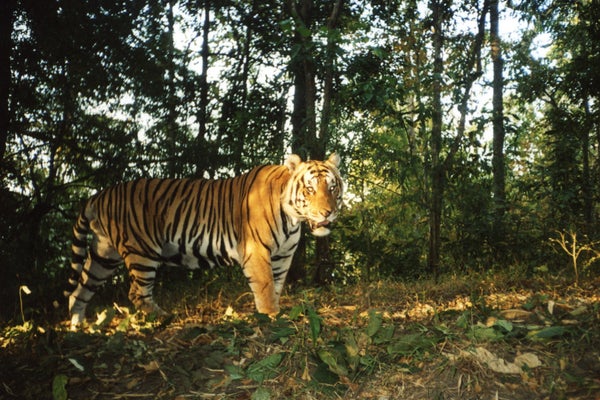This article was published in Scientific American’s former blog network and reflects the views of the author, not necessarily those of Scientific American
Thailand’s wild tigers finally have some good news. Camera traps deployed in Huai Kha Khaeng Wildlife Sanctuary have revealed that its population of Indochinese tigers (Panthera tigris corbetti) has increased from a low of about 35 to 90. According to a study published this month in Conservation Biology, this is now the only tiger population in all of Southeast Asia that is actually growing.
The entire wild population of the Indochinese tiger subspecies was estimated at just 350 animals in 2010. The subspecies can also be found in Laos, Myanmar, Cambodia and Vietnam. It may or may not still exist in China.
The study credits the population increase to intense antipoaching efforts which were put in place in Huai Kha Khaeng in 2006. Armed guards regularly patrol the sanctuary to protect not just the tigers but also the animals the big cats eat.
On supporting science journalism
If you're enjoying this article, consider supporting our award-winning journalism by subscribing. By purchasing a subscription you are helping to ensure the future of impactful stories about the discoveries and ideas shaping our world today.
“The prey, too, have rebounded, which is the reason why we are seeing increased recruitment and reproduction towards end of the period of this study,” says Ullas Karanth, director of the Wildlife Conservation Society’s India Program and a co-author of the new study.
Karanth says Huai Kha Khaeng’s tiger population holds particular importance because it’s what’s called a “source” population of animals which can disperse into the broader range for the species. “These are the areas where there is sufficient prey and protection for some reproduction to take place and provide a small surplus for dispersal and colonization of wider empty forests,” he says, adding that the sanctuary probably now holds the “the largest source population of tigers outside of the Indian continent.”
The ten years of protective efforts have obviously paid off and begun to pay dividends as tigers born over the past few years reach maturity and have the opportunity to reproduce. “We are currently analyzing the tiger data gathered after this study, but it is clear that we are getting more tigers and more cubs in our traps suggesting the population is beginning to take off, based on all the good work,” Karanth says.
Of course, the situation for tigers in Thailand is not completely rosy. Poaching still exists, possibly even with the protected sanctuary. A tiger skin and body parts recovered from poachers this past November was identified, thanks to camera traps photos and her unique fur patterns, as a female known to have lived in Haui Kha Khaeng. Whether her two cubs survived the loss of their mother remains unknown.
Meanwhile, Thailand has a thriving commercial tiger breeding industry which supports cruel and inhumane tourist attractions such as the infamous Tiger Temple, which itself holds more big cats than the entire wild population in Huai Kha Khaeng. Animals from that facility have also been linked to the black market trade in tiger bones and other body parts, according to an investigation published last month by journalist Sharon Guynup in National Geographic. The tigers from this industry are useless for conservation purposes due to rampant inbreeding and poor husbandry. The commercial demand created by commercial industry also puts pressure on wild tigers, as products made from wild animals are more valued in Asian culture.
Still, the population in this sanctuary remains a rare bright spot for Thailand and for all of Southeast Asia’s embattled big cats. Karanth says he expects the tigers in Huai Kha Khaeng to continue their growth and to reach the habitat’s carrying capacity in another 10 to 15 years as long as protective measures remain at their current level.
The broader story for tigers, though, remains bleak. “I always welcome good tiger news because it is so rare,” says wildlife investigator J.A. Mills, author of Blood of the Tiger. She added, “I caution optimism for wild tigers based on reports like this. The key takeaway for me is ‘this is the only site in Southeast Asia where tigers are confirmed to be increasing in population.’ That is scary.”
